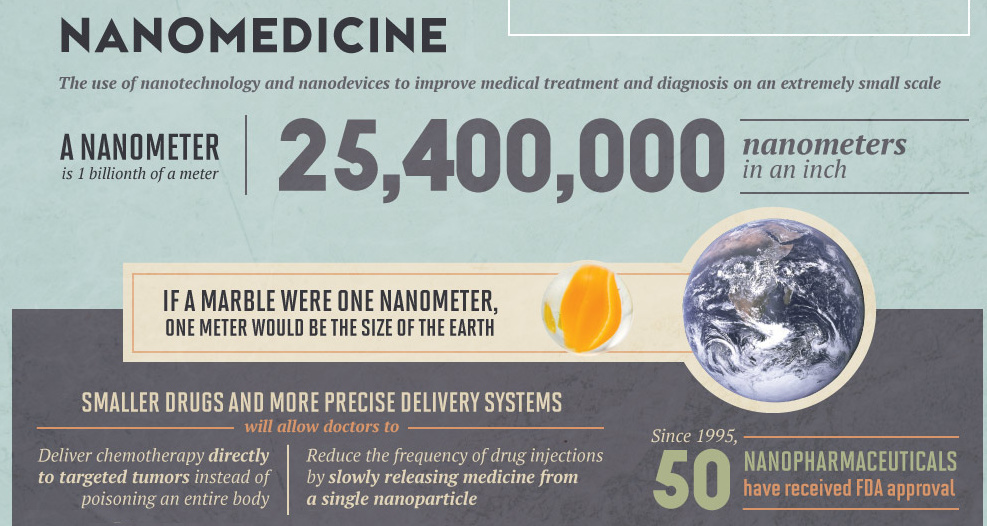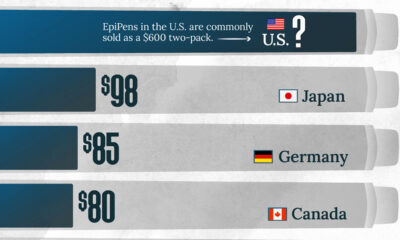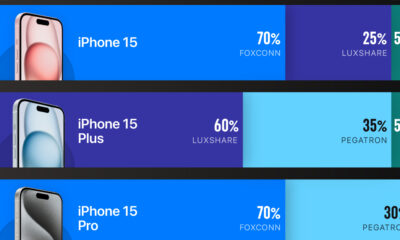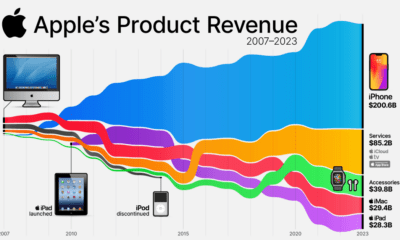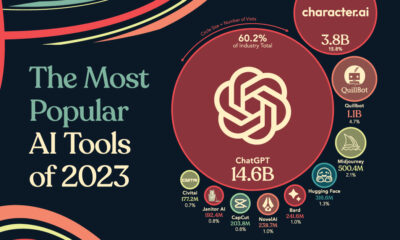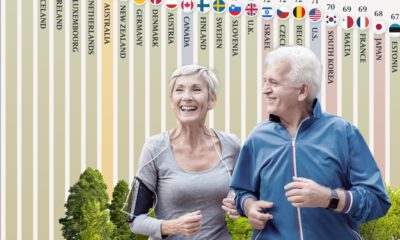Technology
5 Ways Technology is Transforming the Healthcare Industry

5 Ways Tech is Transforming the Healthcare Industry
Whether it’s information-sharing between patients and doctors or aiding in a high-risk surgery, it’s clear that dynamic applications of technology are well underway in disrupting the healthcare industry.
TECH AT OUR FINGERTIPS
Today’s infographic from the Online Medical Care highlights healthcare areas where tech is breaking barriers. Here are five ways that technology is impacting the sector, ranging from AI to nanomedicine:
Artificial Intelligence
Artificial intelligence will have a dramatic impact on many industries, and healthcare is no exception.
A large share of healthcare executives are already applying artificial intelligence in their operations, with data showing plans to increase budgets last year.
| Healthcare uses of AI | Adoption (2017) | Adoption (2018E) |
|---|---|---|
| Clinical decision support | 46% | 59% |
| Population health | 33% | 46% |
| Disease management | 29% | 42% |
| Re-admissions | 33% | 41% |
| Medical costs / health plan | 21% | 38% |
| Patient safety and quality | 25% | 33% |
| Supply chain management | 13% | 21% |
| Cancer care | 4% | 12% |
As the technology becomes more developed and widespread, it’s expected that AI could help diagnose strokes, eye disease, heart disease, skin cancer, and other conditions.
Virtual Healthcare
Also known as telehealth or telemedicine, virtual healthcare allows patients and doctors to touch base remotely using technology such as video conferencing or mobile apps. Many patients are also becoming comfortable using wearable technology to monitor any changes in their health – and sharing that data with their physicians.
Convenience, ease of use, and travel times to their closest doctor are main reasons why patients choose virtual care. On the flip side, many are concerned about the quality of care, or fear a loss of a personal connection with a doctor.
If all patients chose virtual healthcare over face-to-face visits, it could save the U.S. health system $7 billion annually – while the time savings would “free up” the equivalent of 37,000 doctors.
Nanomedicine
Nanomedicine is rapidly evolving field which controls individual atoms and molecules at the extremely minute “nanoscale” of 1 to 100 nanometers. To put that into perspective, a single newspaper sheet is about 100,000 nm thick.
Nanomedicine is mainly used to effectively diagnose, treat, and prevent various diseases. Compared to conventional medicines, it’s much better at precise targeting and delivery systems, paving the way towards combating complex conditions such as cancer.
The global nanomedicine market could be worth over $350 billion by 2025.
Virtual Reality
Although it’s normally been associated with entertainment, virtual reality is making waves in healthcare as well. The multi-sensory, immersive experience that VR provides can benefit both physicians and patients:
- Healthcare worker training
VR can be used to train surgeons in a realistic and low-risk simulated environment. - Physical and mental health
VR offers therapeutic potential and rehabilitation for acute pain and anxiety disorders.
VR is thus considered a cost-effective and efficient tool for both teaching and treatment, and the VR healthcare services market is expected to grow from $8.9 million in 2017 to an expected $285 million in 2022.
3D Printing
3D printing has come a long way since its debut, especially in its uses in the healthcare industry. The technology offers faster prototypes, creating everything from personalized prosthetics to “poly-pills” at a fraction of the cost.
The customizable aspect of 3D printing is revolutionizing organ transplants and tissue repair, and it’s even able to produce realistic skin for burn victims.
Robot-Assisted Surgery
Last but certainly not least, robotic surgery is sweeping through hospitals. It allows doctors to perform delicate and complex procedures that might be otherwise impossible.
Typically, surgeons control a device with a camera and mechanical arms, giving them a high-def view of the surgical site. According to the Mayo Clinic, this method generally:
- Enhances precision, flexibility, and control
- Comes with fewer complications such as infections
- Results in less obvious scars as it is minimally invasive
While technological adoption into the medical field doesn’t come without challenges, the value is clear – and we’ve barely scratched the surface of tech-driven possibilities in the healthcare industry.
Technology
All of the Grants Given by the U.S. CHIPS Act
Intel, TSMC, and more have received billions in subsidies from the U.S. CHIPS Act in 2024.

All of the Grants Given by the U.S. CHIPS Act
This was originally posted on our Voronoi app. Download the app for free on iOS or Android and discover incredible data-driven charts from a variety of trusted sources.
This visualization shows which companies are receiving grants from the U.S. CHIPS Act, as of April 25, 2024. The CHIPS Act is a federal statute signed into law by President Joe Biden that authorizes $280 billion in new funding to boost domestic research and manufacturing of semiconductors.
The grant amounts visualized in this graphic are intended to accelerate the production of semiconductor fabrication plants (fabs) across the United States.
Data and Company Highlights
The figures we used to create this graphic were collected from a variety of public news sources. The Semiconductor Industry Association (SIA) also maintains a tracker for CHIPS Act recipients, though at the time of writing it does not have the latest details for Micron.
| Company | Federal Grant Amount | Anticipated Investment From Company |
|---|---|---|
| 🇺🇸 Intel | $8,500,000,000 | $100,000,000,000 |
| 🇹🇼 TSMC | $6,600,000,000 | $65,000,000,000 |
| 🇰🇷 Samsung | $6,400,000,000 | $45,000,000,000 |
| 🇺🇸 Micron | $6,100,000,000 | $50,000,000,000 |
| 🇺🇸 GlobalFoundries | $1,500,000,000 | $12,000,000,000 |
| 🇺🇸 Microchip | $162,000,000 | N/A |
| 🇬🇧 BAE Systems | $35,000,000 | N/A |
BAE Systems was not included in the graphic due to size limitations
Intel’s Massive Plans
Intel is receiving the largest share of the pie, with $8.5 billion in grants (plus an additional $11 billion in government loans). This grant accounts for 22% of the CHIPS Act’s total subsidies for chip production.
From Intel’s side, the company is expected to invest $100 billion to construct new fabs in Arizona and Ohio, while modernizing and/or expanding existing fabs in Oregon and New Mexico. Intel could also claim another $25 billion in credits through the U.S. Treasury Department’s Investment Tax Credit.
TSMC Expands its U.S. Presence
TSMC, the world’s largest semiconductor foundry company, is receiving a hefty $6.6 billion to construct a new chip plant with three fabs in Arizona. The Taiwanese chipmaker is expected to invest $65 billion into the project.
The plant’s first fab will be up and running in the first half of 2025, leveraging 4 nm (nanometer) technology. According to TrendForce, the other fabs will produce chips on more advanced 3 nm and 2 nm processes.
The Latest Grant Goes to Micron
Micron, the only U.S.-based manufacturer of memory chips, is set to receive $6.1 billion in grants to support its plans of investing $50 billion through 2030. This investment will be used to construct new fabs in Idaho and New York.
-

 Debt1 week ago
Debt1 week agoHow Debt-to-GDP Ratios Have Changed Since 2000
-

 Markets2 weeks ago
Markets2 weeks agoRanked: The World’s Top Flight Routes, by Revenue
-

 Countries2 weeks ago
Countries2 weeks agoPopulation Projections: The World’s 6 Largest Countries in 2075
-

 Markets2 weeks ago
Markets2 weeks agoThe Top 10 States by Real GDP Growth in 2023
-

 Demographics2 weeks ago
Demographics2 weeks agoThe Smallest Gender Wage Gaps in OECD Countries
-

 United States2 weeks ago
United States2 weeks agoWhere U.S. Inflation Hit the Hardest in March 2024
-

 Green2 weeks ago
Green2 weeks agoTop Countries By Forest Growth Since 2001
-

 United States2 weeks ago
United States2 weeks agoRanked: The Largest U.S. Corporations by Number of Employees

